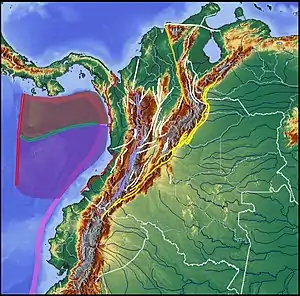Romeral Fault System
The Romeral Fault System (Spanish: Sistema de Fallas (de) Romeral) is a megaregional system of major parallel and anastomosing faults in the Central Ranges of the Colombian Andes and the Cauca, Amagá, and Sinú-San Jacinto Basins. The system spans across ten departments of Colombia, from northeast to south Bolívar, Sucre, Córdoba, Antioquia, Caldas, Risaralda, Quindío, Valle del Cauca, Cauca and Nariño. The fault zone extends into Ecuador where it is known as the Peltetec Fault System. The in detail described part of the Romeral Fault System south of Córdoba has a total length of 697.4 kilometres (433.3 mi) with a cumulative length of 1,787.9 kilometres (1,110.9 mi) and runs along an average north to south strike of 017.6 ± 16, cross-cutting the central-western portion of Colombia.
The fault system, active during more than 200 million years from the Triassic to recent, represents the ancient western continental margin of northwestern South America and forms the boundary between obducted oceanic crust to the west of the fault zone and continental crust to the east. The Romeral Fault System is situated at the intersection of five tectonic plates; the Caribbean Plate in the north, the Panama, Coiba and Malpelo Plates, formerly considered part of the Nazca Plate to the west and the North Andes Plate where the fault system is located. The Romeral Fault System forms the structural boundary between the Western and Central Ranges of the Colombian Andes. The tectonic depression produced by the fault zone in the central and southern portion is filled by the valley of the Cauca River, the second-most important fluvial artery of Colombia after the Magdalena River.
The major active volcanoes of Colombia, such as Galeras and Romeral are underlain by the Romeral Fault System. Segments of the fault zone are active, producing many minor and occasional devastating earthquakes, such as the 1983 earthquake in Popayán, Cauca and the 1999 Armenia earthquake, with a combined total of more than 2000 casualties. The capitals of Sucre (Sincelejo), Antioquia (Medellín), Caldas (Manizales), Quindío (Armenia), Risaralda (Pereira), Valle del Cauca (Cali), Cauca (Popayán) and Nariño (Pasto) are all situated near or on top of the fault zone.
Etymology
The Romeral Fault System is named after the volcano Romeral, located in the centre of the fault zone. The system has received various names as Romeral Lineament (Spanish: Lineamiento Romeral),[1][2] Romeral Fault,[3] Romeral Fault Zone,[4] Romeral Shear Zone,[5] and many individual segments of the system are known by local names.[6]
Description
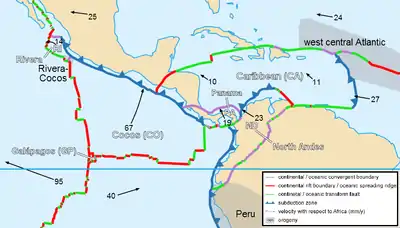
CP - Caribbean Plate
NAP - North Andes Plate
SAP - South American Plate
MP - Malpelo Plate
CMP - Coiba microplate
PMP - Panama microplate
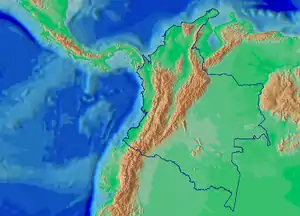

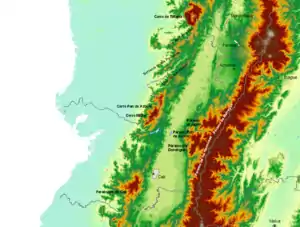
The megaregional Romeral Fault System represents the geological boundary between the Western and Central Ranges of the Colombian Andes.[7] The fault system was active since the Triassic.[8] During the Cretaceous, this was the western margin of northwestern South America.[9] It is one of the most active and continuous fault systems in Colombia. It extends southward into Ecuador and is known there as the Peltetec Fault System.[10] In the literature, several names have been applied to the fault system as it traverses the length of the country. The oldest name is the Guayaquil-Dolores Megashear, which involves a whole set of parallel fractures in western Colombia. The number of faults that comprise the width of the system ranges between three and five, depending upon location in the country. Near latitude 7° N, the fault system includes the Peque, Heliconia, Sabanalarga, and Cauca Occidental Faults, mainly in the department of Antioquia. Farther south, between about latitudes 1° and 5° N, the faults are known from north to south as the Pijao-Silvia, Quebradagrande, Potrerillos, Guabas-Pradera, Cauca-Almaguer, Rosas-Julumito, Popayán, Paispamba, El Rosal, and Buesaco Faults.[6]
The fault system with described segments totalling almost 700 kilometres (430 mi) in length comprises several parallel regional fractures (faults) that form the transition zone between oceanic rocks to the west and continental rocks to the east. The geology of the western domain consists of an ophiolitic belt with oceanic gabbroic, basaltic and sedimentary rocks of Cretaceous age. The eastern domain consists primarily of continentalised metamorphic schistose, oceanic, and continental rocks, mainly of Paleozoic age. The Romeral Fault System forms a 20 to 40 kilometres (12 to 25 mi) wide deformed belt that is parallel to the western slope of the Central Ranges of the Colombian Andes; it extends from the Gulf of Guayaquil in Ecuador in the south through Colombia to the Caribbean Sea in the north. At least one ancient subduction zone is believed to underlay some parts of the zone. Although this is the most studied fault system in Colombia, little is still known about its paleoseismic characteristics (most recent faulting, slip rates, and recurrence intervals).[6] Parallel to the Romeral Fault System runs the Cauca-Pujilí Fault that also extends into Ecuador in the south. The two fault zones converge in the northern part of the Cauca Basin.[11]
The fault system is reverse sinistral (left lateral) in the northern part of the country, conspicuous to about latitude 5° N, from there south to Ecuador, it is mainly reverse-dextral (right lateral). The system forms prominent fault lines and well-developed fault scarps as much as 400 metres (1,300 ft) high on Pleistocene-aged sedimentary deposits, and eroded scarps on older Cretaceous to Paleozoic rocks. The system forms an outstanding break-in-slope above the easternmost parallel set of faults. The upper part of the easternmost major scarps forms the topographic divide of the Central Ranges of Colombia. Regional neotectonic features include linear valleys, offset drainages, aligned creeks, triangular facets, saddles, and L-shaped spurs and linear ridges. The fault offsets Quaternary volcanic rocks, alluvium and colluvium.[12]
Segments
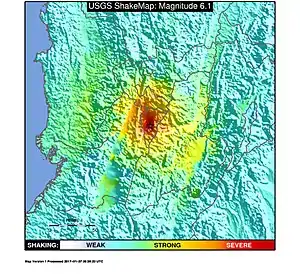

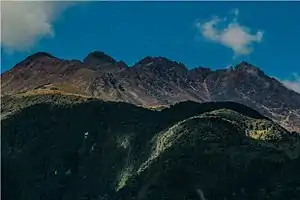
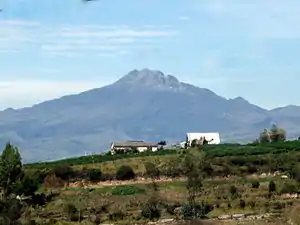
Several segments of the Romeral Fault System have been identified under different names in the geological literature. The system starts as the Romeral Lineament in northern Colombia, in the department of Bolívar, where the lineament is covered by young sediments and runs parallel to and southeast from the Guamo Anticlinal,[1] continuing into Sucre, where the lineament runs east of Sincelejo along a north–south strike,[2] into Córdoba through Montelíbano.[14]
Cauca-Almaguer Fault
The Cauca-Almaguer Fault is a name given to several segments of the Romeral Fault System. In the north, the segment bearing this name starts in Puerto Libertador, Córdoba, and extends southward into Antioquia. Between Bolombolo and Santa Fe de Antioquia, the fault covers a zone of 2 to 5 kilometres (1.2 to 3.1 mi) wide with anastomosing fault segments. The fault connects to the Sabanalarga East Fault.[15] The fault delimits the western edge of the Arquía Complex schists.[16] In the department of Risaralda, the system receives the name Cauca-Almaguer Fault again, running east of Pereira.[17] The name appears again in the department of Valle del Cauca, bordering Cali to the west,[13] and in Cauca east of Popayán.[18]
Sabanalarga East Fault
The Sabanalarga East Fault is the segment of the Romeral Fault System in Antioquia between Sabanalarga in the north and Liborina in the south.[3]
Romeral Fault
The system is known as Romeral Fault when cutting north to south through the department of Caldas, where the fault runs west of Manizales.[19]
Montenegro Fault
The Montenegro Fault runs through the western slope of the Central Ranges. The fault is located to the west of the city of Armenia. The fault crosscuts and deforms the Pleistocene volcanic and volcano-sedimentary deposits of the Quindío Fan (Abanico del Quindío), which covers about 400 square kilometres (150 sq mi).[12]
Armenia Fault
The Armenia Fault is part of the Romeral Fault System on the western slope of the Central Ranges. The fault runs west of Pereira and the Cauca-Almaguer Fault in the department of Risaralda.[17] Farther south, the fault crosses the city of Armenia and displaces Pliocene to Pleistocene volcanic and volcano-sedimentary deposits of the Quindío Fan. The geometric and neotectonic features of the Montenegro and Armenia Faults are very similar.[20]
Córdoba-Navarco Fault
This section of the fault system is formed by the locally named Córdoba and Navarco Faults, which are eastern strands of the Romeral Fault System, south of the city of Armenia. These faults lie within the epicentre area of the Armenia earthquake of January 25, 1999. The faults extend through sheared cataclastic and undeformed basaltic and sedimentary Cretaceous oceanic rocks, cropping out on the eastern slope of the Central Ranges.[21]
Paraíso Fault
The Paraíso Fault is located at the western slope of the Central Ranges, east of the city of Palmira. The fault displaces alluvial fans and debris flows on the eastern border of the department of Valle del Cauca. North of the Amaime River, the fault seems to be more active in late Quaternary than the portion south of the river. Two trenches were opened in the northern part: the Venecia and Piedechinche trenches, each of which show Holocene tectonic deformation.[22]
Piendamó Fault
The Piendamó Fault is located at the base of the mountain front of the western slope of the Central Ranges, north of the city of Popayán, Cauca. The fault displaces pyroclastic deposits and mud flows of the Tertiary to Quaternary Popayán Formation. It forms an outstanding topographic and tectonic block bounded by two intersecting faults.[23]
Rosas-Julumito Fault
The Rosas-Julimito Fault is a rather short section of about 43 kilometres (27 mi) length, 17 kilometres (11 mi) of which have active tectonic movement. The fault section parallels the Cauca-Almaguer Fault, which is one of the largest older fracture zones in western Colombia. The Rosas-Julumito Fault runs about 5 kilometres (3.1 mi) west of the city of Popayán. The fault crosses the Pliocene-Pleistocene Popayán Formation, which consists of pyroclastic flow, mud flow and ash-fall deposits. It is believed that either the Rosas Fault or the nearby Julumito Fault (less than 2 kilometres (1.2 mi) to the west) produced the earthquake of March 31, 1983 that partially destroyed the city of Popayán.[24] The fault is noted in the south of the Cauca Department.[25]
Popayán Fault
The Popayán Fault segment of the Romeral Fault System is noted near the village of Timbío in the department of Cauca, joining to the south with the Rosas-Julumito Fault. Here, also the Silvia-Pijao Fault segment is present, just west of the Sotará volcano.[25]
Buesaco-Aranda Fault
The Buesaco-Aranda Faults, which are parallel, extend in a north-northeast to northeast direction from near the Galeras Volcano in southwestern Colombia. The Buesaco Fault is located 5 kilometres (3.1 mi) to the west of the Aranda Fault. On the eastern block of the Buesaco Fault, the basement rock consists of basic volcanic, andesite and dark sedimentary rocks which probably developed in a marginal basin environment during Early Cretaceous time. On the western block of the fault are a group of low-grade metamorphic rocks which consist of greenschist, amphibolite, quartzite and black schist, all of Paleozoic age. The area is mostly covered by a Pliocene blanket of pyroclastic rocks and calc-alkaline lavas, Quaternary lahar deposits and fluvio-glacial deposits.[26]
Silvia-Pijao Fault
The Silvia-Pijao segment continues southward from Popayán, where it runs parallel to the Cauca-Almaguer and Buesaco Faults.[27] Farther south, this segment of the fault system runs just north of Pasto, the capital of Nariño and this fault trace continues into Ecuador, crossing the border east of the Chiles and Cerro Negro volcanoes.[28]
Geology
| Paleogeography of Colombia | |
 |
170 Ma |
 |
150 Ma |
 |
120 Ma |
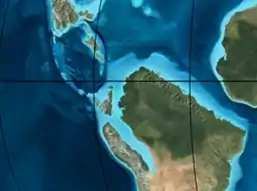 |
90 Ma |
 |
65 Ma |
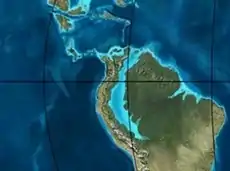 |
50 Ma |
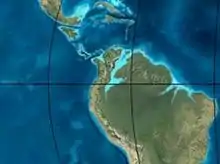 |
35 Ma |
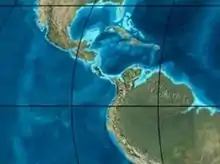 |
20 Ma |
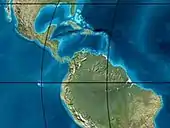 |
Present |
Geometrically, the Romeral shear zone is characterised by an anastomosed arrange of faults yielding a block tectonic configuration, interpreted as an extensive shear zone (kilometric-scale) composed of multiple lithological units of varying ages, diverse origins, poly-deformed, and in faulted contact, which González (1980) named the Romeral Mélange. The system has been traditionally considered as a strike-slip shear zone, however, systematic observation of thrust faults suggests the importance of a compressive component of the system, configuring a dominant transpressive regime at least for the Cenozoic and eventually the Upper Cretaceous. Evidences for post-Coniacian thrusting of Quebradagrande volcanics over a feldspar granitoid, and post-Miocene thrusting of ultramafic rocks over Oligo-Miocene clastic rocks of the Amagá Formation are reported.[5] The fault zone separates the Barroso Formation from the Quebradagrande Complex. Both units are comparable in lithology, the Barroso Formation consisting of basalts, andesites and pyroclastic rocks and the Quebradagrande Complex comprising basalts, andesites, pyroclastic rocks and gabbros.[29] Cooling ages of the volcanics have been estimated at the Early Cretaceous, between 127 and 119 Ma.[30]
Regionally, the Romeral Fault System separates the Central from the Western Ranges and corresponds to an extensive shear zone hosting a series of rocks;
- Early Cretaceous volcano-sedimentary rocks of the Quebradagrande Complex, characterised by mid-ocean ridge basalts (MORB) and arc-related rocks
- Low-grade possibly Paleozoic meta-sedimentary rocks grouped into the Sinifaná-Meta sediments
- Mafic and ultramafic Triassic intrusives
- Permian and/or Cretaceous low-to-medium-grade meta-volcano-sedimentary N-MORB type sequences of the Arquía Complex
These older rock units are unconformably overlain by the Oligocene-Miocene coal-bearing Amagá Formation and the Mio-Pliocene volcanics of the Combia Formation.[5]
Tectonic history
The western part of present-day Colombia was affected by a series of large-scale tectonic movements from the Mesozoic to Cenozoic. The tectonic history of the Romeral Fault System is determined by several phases of plate tectonic movements:[31]
- Subduction of the Farallones Plate during the Jurassic to Cretaceous
- East- and northeastward movement of the Caribbean Plate relative to South America since the Cretaceous to Miocene
- Break-up of the Farallones Plate into the Cocos and Nazca Plates in the Late Oligocene (around 25 Ma)
- Eastward subduction of the Coiba and Malpelo Plates, formerly considered the northern portion of the Nazca Plate since the Miocene
- Accretion of allochtonous geologic terranes Western Ranges and Serranía del Baudó in the Late Cretaceous and Miocene to Pliocene respectively
The fault system reached its "actual" configuration when the trans-American plate boundary (the fundamental pre-Aptian east-dipping subduction zone located to the west of the American margin) underwent a major transformation to a southwest dipping subduction zone beneath the future Caribbean Arc, impelling the closure of the Quebradagrande oceanic arc-back arc system.[30] Initiation of this arc is likely constrained by HP-LT metamorphic rocks present in the circum-Caribbean subduction complexes, including examples from Colombia in the Barragán area (Valle del Cauca).[32]
Three Neogene phases of strike-slip faulting along the Romeral Fault System have been deduced from the formation of the Irrá Basin, the deformation of its sediments, and rotation of its remagnetised sediments. The corresponding ages and slip-sense of these phases are Late Miocene right-lateral (syndepositional), approximately Pleistocene left-lateral (syndeformational), Pleistocene to recent right-lateral (rotation of the remagnetised Irrá Formation). An additional phase, of left-lateral present-day slip has been deduced from microseismicity activity.[33]
Activity
Individual fault segments of the Romeral Fault System have slip rates ranging from 0.2 to 1.2 millimetres (0.0079 to 0.0472 in) per year.[34] The fault system is active and produced two major earthquakes in Colombia; an Mw 5.5 earthquake in 1983 destroying the capital of Cauca, Popayán, and in 1999 (Mw 6.2) devastating the capital of Quindío, Armenia.[35][36]
See also
References
- Mapa Geológico Bolívar 1:400,000, 1999
- Mapa Geológico Sucre 1:250,000, 1999
- Mapa Geológico Antioquia 1:400,000, 1999
- Sierra et al., 2012
- Vinasco & Cordani, 2012, p.113
- Paris et al., 2000, p.19
- Rodríguez & Zapata, 2013, p.40
- Vinasco & Cordani, 2012, p.121
- Vinasco & Cordani, 2012, p.112
- Marín & Vinasco, 2012, p.61
- Sierra et al., 2012, p.145
- Paris et al., 2000, p.20
- Plancha 300, 1985
- Mapa Geológico Córdoba 1:250,000, 1997
- Gónzalez, 2001, p.183
- Gónzalez, 2001, p.182
- Mapa Geológico Risaralda 1:200,000, 1990
- Plancha 342, 1999
- Mapa Geológico Caldas 1:250,000, 1990
- Paris et al., 2000, p.21
- Paris et al., 2000, p.25
- Paris et al., 2000, p.22
- Paris et al., 2000, p.23
- Paris et al., 2000, p.24
- Plancha 364, 1999
- Paris et al., 2000, p.26
- Plancha 411, 2002
- Plancha 5-18, 2015
- Rodríguez & Zapata, 2013, p.54
- Vinasco & Cordani, 2012, p.117
- Ramírez et al., 2012, p.125
- Vinasco & Cordani, 2012, p.118
- Sierra et al., 2012, p.157
- Paris et al., 2000, pp.20–26
- Marín Arias et al., 2006, p.94
- USGS. "M 6.1 - Colombia". United States Geological Survey. Retrieved 2017-09-18.
Bibliography
- Marín Arias, J.P.; H. Castillo González, and E. de J. Salcedo Hurtado. 2006. Modelo geométrico del foco del terremoto de Popayán (Colombia) a partir de datos macrosísmicos. Boletín de Geología 28. 93–109. Accessed 2017-09-18.
- Marín Cerón, María Isabel, and Cesar Vinasco Vallejo. 2012. Contribución al conocimiento de la evolución geológica del sistema de fallas de Romeral. Boletín Ciencias de la Tierra 32. 61–64.
- Paris, Gabriel; Michael N. Machette; Richard L. Dart, and Kathleen M. Haller. 2000a. Map and Database of Quaternary Faults and Folds in Colombia and its Offshore Regions, 1–66. USGS. Accessed 2017-09-18.
- Ramírez L., Jackeline; Gloria M. Sierra L., and María I. Marín C. 2012. Anisotropía de Susceptibilidad Magnética (ASM) del miembro superior de la Formación Amagá, sección Quebrada Sabaleticas, SW antioqueño y su relacion con los movimientos del Sistema de Fallas Romeral en el Cenozóico Tardío. Boletín Ciencias de la Tierra 32. 125–142.
- Rodríguez G., Gabriel, and Gilberto Zapata G. 2013. Análisis comparativo entre la Formación Barroso y el Complejo Quebradagrande: un arco volcánico toleítico-calcoalcalino, segmentado por el Sistema de Fallas de Romeral en los Andes del Norte?. Boletín Ciencias de la Tierra 33. 39–58.
- Sierra, G.M.; M.I. Marín Cerón, and W. MacDonald. 2012. Tectonic evolution of the Irrá pull-apart basin evidences of slip reversals on the Romeral Fault Zone, northern part of Andean Central Cordillera, Colombia. Boletín Ciencias de la Tierra 32. 143–159.
- Vinasco, Cesar, and Umberto Cordani. 2012. Reactivation episodes of the Romeral Fault System in the northwestern part of Central Andes, Colombia, through 39Ar-40Ar and K-Ar results. Boletín Ciencias de la Tierra 32. 111–124.
Maps
- Paris, Gabriel; Michael N. Machette; Richard L. Dart, and Kathleen M. Haller. 2000b. Map of Quaternary Faults and Folds of Colombia and Its Offshore Regions, 1. USGS. Accessed 2017-09-18.
- Gómez Tapias, Jorge; Nohora Emma Montes Ramírez; Álvaro Nivia Guevara, and Hans Diederix. 2015. Plancha 5-18 del Atlas Geológico de Colombia 1:500,000, 1. Servicio Geológico Colombiano. Accessed 2017-09-21.
Departmental
- González, Humberto; Ubaldo Cossio; Mario Maya; Edgar Vásquez, and Magdalí Holguín. 1999. Mapa Geológico de Antioquia 1:400,000, 1. INGEOMINAS. Accessed 2017-09-21.
- Clavijo Torres, Jairo; Laura Yaneth Reyes Ortiz, and Ana Milena Cardozo Ortiz. 1999. Mapa Geológico de Bolívar 1:400,000, 1. INGEOMINAS. Accessed 2017-09-21.
- González I, Humberto. 1990. Mapa Geológico de Caldas 1:250,000, 1. INGEOMINAS. Accessed 2017-09-21.
- Marín, P.; G. Paris; A. Orrego, and M.E. López. 1979. Mapa Geológico de Cauca 1:350,000, 1. INGEOMINAS. Accessed 2017-09-21.
- Londoño G., Ana Cristina, and Humberto González I. 1997. Mapa Geológico de Córdoba 1:250,000, 1. INGEOMINAS. Accessed 2017-09-21.
- González I., Humberto. 2000. Mapa Geológico de Risaralda 1:200,000, 1. INGEOMINAS. Accessed 2017-09-21.
- Barrera Olmos, Rodolfo, and Alexandra Urrego. 1999. Mapa Geológico de Sucre 1:250,000, 1. INGEOMINAS. Accessed 2017-09-21.
- Nivia, A.; W.J. McCourt; J.A. Aspden; M. De Armas, and J.W. Aucott. 2001. Mapa Geológico del Valle del Cauca 1:250,000, 1. INGEOMINAS. Accessed 2017-09-21.
Local
- Mc Court, William J., and Germán Verdugo. 1985. Plancha 300 - Cali - 1:100,000, 1. INGEOMINAS. Accessed 2017-06-06.
- Orrego, Abigail, and Gabriel París. 1999. Plancha 342 - Popayán - 1:100,000, 1. INGEOMINAS. Accessed 2017-06-06.
- Orrego, Abigail; Luis León; Luis Eduardo Padilla; Álvaro Pablo Acevedo, and Nelson Marulanda. 1999. Plancha 364 - Timbío - 1:100,000, 1. INGEOMINAS. Accessed 2017-06-06.
- Núñez, Alberto, and Jorge Gómez. 2002. Plancha 411 - La Cruz - 1:100,000, 1. INGEOMINAS. Accessed 2017-06-06.
Further reading
- Page, W.D. 1986. Seismic geology and seismicity of Northwestern Colombia, 1–200. San Francisco, California, Woodward-Clyde Consultants Report for ISA and Integral Ltda., Medellín.


